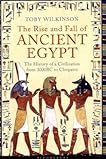 The Rise and Fall of Ancient Egypt by Toby Wilkinson
The Rise and Fall of Ancient Egypt by Toby Wilkinson
My rating: 4 of 5 stars
In the future, when someone uses the phrase, “monumental effort,” I will think of this book.
Mr. Wilkinson has not only attempted, but delivered, a summary history of the Egyptian civilization, from conception to Cleopatra.
Aside from the scope of the work, coupled with actually having achieved it, the most remarkable thing about this book is that Mr. Wilkinson was able to craft such an accessible work.
Even when faced with source material that was both sparse, thousands of years old and almost exclusively the output of dictatorial propaganda departments, Mr. Wilkinson created a narrative that is both engaging and enlightening for the everyday, non-academic reader.
To give some perspective to the scale of the timeline involved, Thutmose IV, who reigned from 1399 BC to 1389 BC, excavated and restored the Great Sphinx of Giza, built by a previous Pharaoh, which was by then buried in shifting sands and already more than 1,000 years old. In today’s world of countries that are mostly less than 300 years old, it is challenging to imagine unearthing a national monument 1,000 years old in a nation that would survive 1,000 years more.
Thutmose IV is but one of 168 Pharaohs who are individually addressed in the book, along with relevant geopolitical and regional context for their times. Somehow, Mr. Wilkinson has derived, extracted and discovered anecdotes that illuminate the life and times of many of these pharaohs, from the famous, such as Tutankhamun and Cleopatra, to the obscure, such as Neferefra and Sobekemsaf II.
While pedants may long for more detail and champions of a particular period, Kingdom or Pharaoh may wish for a more sympathetic endorsement, the overall tone of the book is even and mostly suitably detached, all while avoiding academic sterility. The flaw in this regard is the author’s persistent hectoring of the ancient Egyptians for not being a replica of modern Sweden, along with its leading U.N. Gini index. Despite his sterling credentials, Mr. Wilkinson loses perspective and thus credible assessment of the realities of ancient societies when he repeatedly calls the ancient Egyptian theocratic dictatorships to task for not being more of a socialist paradise. It is hard to imagine how such a goal could have been either achieved or sustained in an era of almost universal illiteracy, cultural isolation and xenophobia. However, in the scope of a work of this magnitude, this is a minor quibble.
It is daunting to even consider addressing, in a meaningful way, a time span of 3,000 years. Mr. Wilkinson has done so, and in a very readable and entertaining fashion.